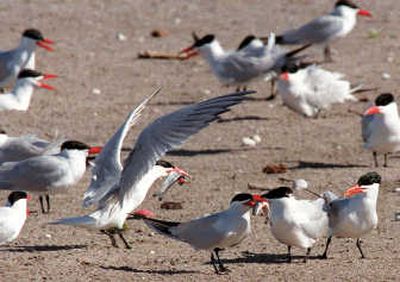Cormorants join Columbia feed

CHINOOK, Wash. – There’s a hungry new bird on the Columbia River.
For years Caspian terns at the mouth of the river bedeviled salmon recovery efforts by eating millions of the same fish the government put billions of dollars into saving.
But now they’re not the only ones.
Double-crested cormorants are multiplying so fast in an island colony that they now outnumber the terns. Cormorants weigh four times as much as the terns, and biologists suspect they’re now eating as many if not more salmon, including federally protected species.
The federal government took years devising plans for the terns. The U.S. Army Corps of Engineers is about to spend $4 million luring them to new nesting sites in Oregon and California where they won’t eat as many salmon.
But cormorant numbers climbed so quickly no one is sure what, if anything, to do. Bird advocates say the cormorants shouldn’t be blamed for eating salmon when dams and loss of habitat hammer the fish harder.
The cormorant colony exploded from fewer than 100 pairs in 1989 to about 14,000 today, making it the largest in the world. It now holds about half of all the cormorants on the West Coast. The jet-black birds have overrun the west end of East Sand Island, a strip of rock and sand near the north side of the Columbia where their caustic droppings burned away thick grass that once grew there.
“The terns were very obviously a bigger problem when we got started,” said Don Lyons, a doctoral student at Oregon State University helping to lead research on the birds. “But that may be starting to shift now.”
The bird boom comes as biologists have increasingly identified the Columbia River estuary, where the birds concentrate, as a vital stopover for salmon on their push seaward – a kind of “Head Start” program for fish. Studies suggest salmon that build strength in estuaries have a better chance of returning from the sea years later to spawn.
“The more we look at the estuary, the more interesting it is in terms of its role,” said John Ferguson, director of the fish ecology division at the federal Northwest Fisheries Science Center.
But the findings mean the multiplying birds might be going after salmon that have the greatest promise of reproducing, at a critical period in the life cycle of the fish.
It’s not clear why the cormorants teem at the mouth of the Columbia, but scientists have a few theories.
They suspect cormorants, like many other birds, suffered from the pesticide DDT that built up in the food chain and caused their eggshells to break prematurely. The species may still be bouncing back from when DDT was banned in 1972, Lyons said. Levels of the toxin in the environment continue to fade.
Another factor may be that bald eagles, also recovering from effects of DDT, have grown in number and broken up cormorant colonies elsewhere on the West Coast.
Bald eagles prey on cormorants, and there are reports that cormorant colonies, especially in coastal British Columbia, have shrunk or disappeared as bald eagles have expanded, Lyons said. Those cormorants may have moved to the Columbia River, seeking safety in numbers with the bonus of plentiful fish to eat.
“Some seabirds are experiencing a lot more disturbance than they were in the ‘60s and ‘70s when the eagles were scarce,” said Daniel Roby, the OSU professor overseeing the research on cormorants and terns.
Though OSU researchers have watched bald eagles attack cormorants in the Columbia estuary, too, the predators don’t nab enough cormorants to dent the huge colony.
The cormorants are also skittish around people, and disturbance of their habitat elsewhere might also be pushing them together.
The birds lay up to a half-dozen eggs each year in nests of jumbled sticks, and they average more than two surviving chicks a year, Lyons said. That lets them multiply quickly when conditions are good.
Terns, by comparison, build their numbers more slowly – averaging only about one surviving chick a year.
The terns depend on salmon for as much as half their diet, and they used to eat more than 12 million a year, according to federal estimates. Then the Corps of Engineers lured them in 2000 to East Sand Island, where they now nest at the opposite end from the cormorants.
That put the terns closer to the ocean and fish besides salmon, so they now eat fewer salmon – nearly 5 million or so.
Cormorants dive deeper for food, so they eat a wider range of fish than terns – relying less heavily on salmon. But their larger size and appetite makes up for that.
Salmon represent “a smaller portion of what they eat, but they eat so much more overall, the number of salmon they’re eating is now comparable,” Lyons said.
Geoff Dorsey, a Corps of Engineers wildlife biologist said the corps backs the OSU studies of the cormorant colony, but remains a few years from any decision on whether to try to move or control them.